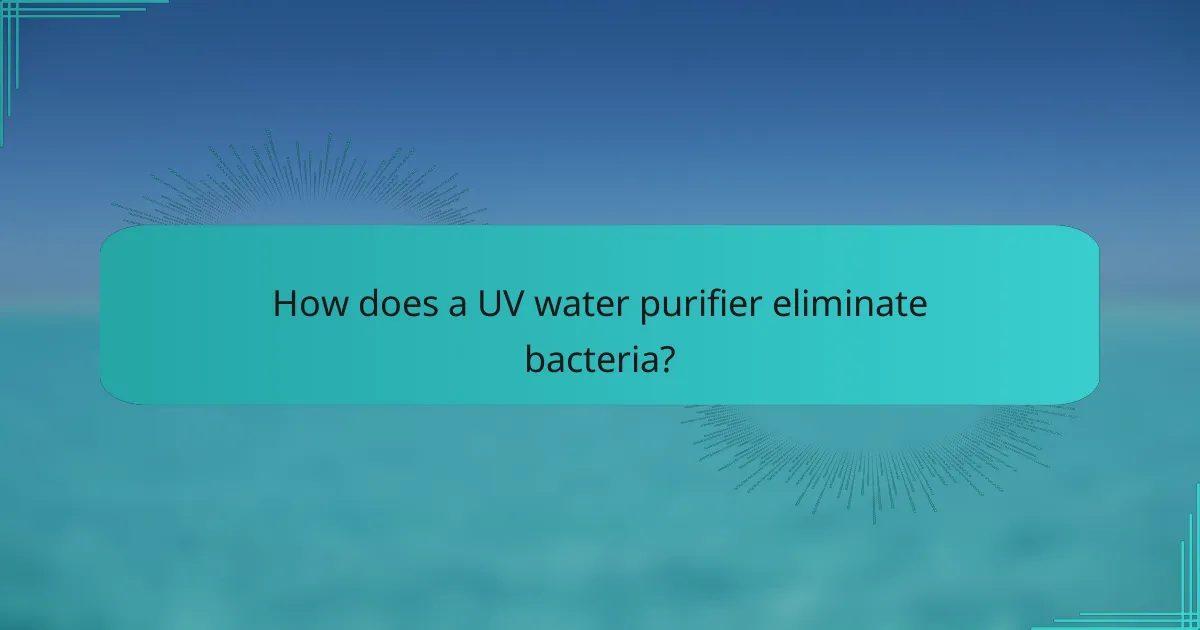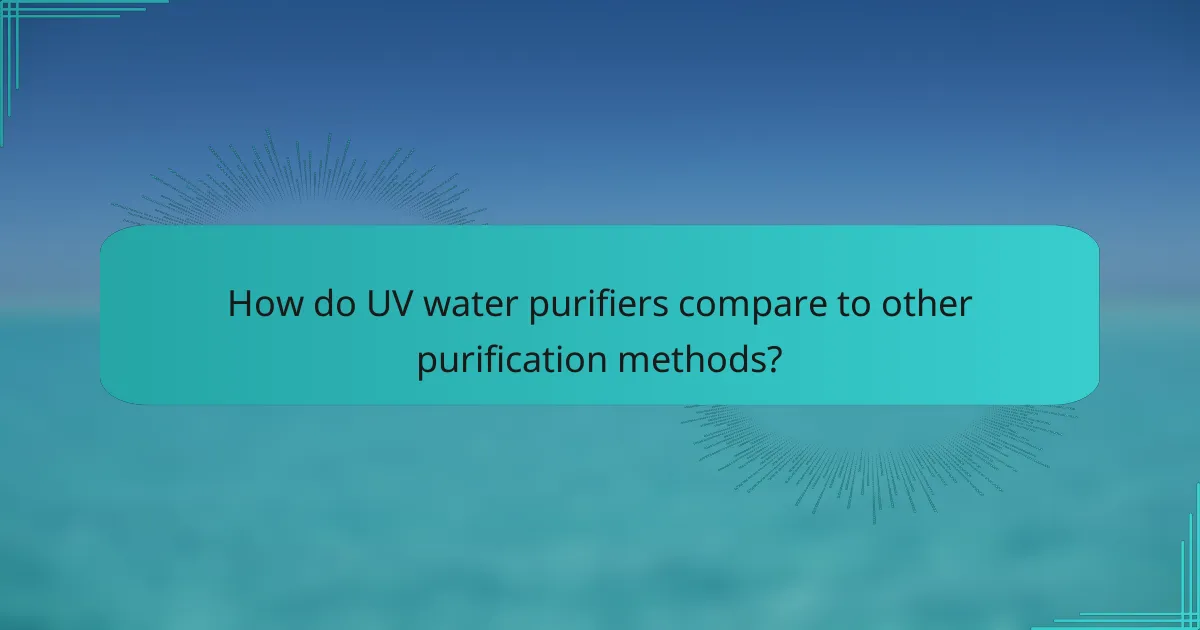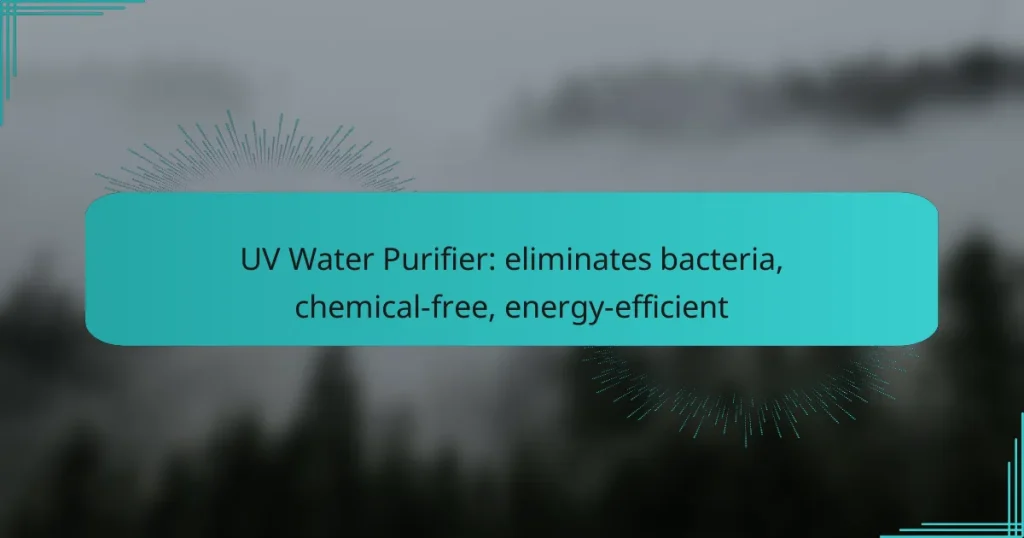A UV water purifier is an innovative solution that uses ultraviolet light to effectively eliminate bacteria from drinking water without the use of chemicals. This energy-efficient technology not only ensures safe and clean water but also requires minimal maintenance, making it an ideal choice for households. By considering factors like flow rate and certification standards, you can select a purifier that meets your specific needs while providing peace of mind.

How does a UV water purifier eliminate bacteria?
A UV water purifier eliminates bacteria by using ultraviolet light to disrupt their cellular functions. This chemical-free method is energy-efficient and effectively reduces harmful microorganisms in water.
Uses UV-C light technology
UV water purifiers utilize UV-C light, a specific wavelength of ultraviolet light that is effective in killing bacteria and viruses. This technology is widely recognized for its ability to disinfect water without the use of chemicals, making it a safe choice for households and businesses alike.
The UV-C light is typically generated by a mercury vapor lamp or a low-pressure mercury lamp, which emits light at a wavelength of around 254 nanometers. This wavelength is optimal for inactivating microorganisms, ensuring that the water is safe for consumption.
Destroys DNA of microorganisms
The primary mechanism by which UV water purifiers eliminate bacteria is by destroying their DNA. When microorganisms are exposed to UV-C light, their genetic material absorbs the energy, leading to the formation of dimers in the DNA strands. This process prevents the microorganisms from replicating and effectively kills them.
This DNA destruction is crucial because it not only eliminates existing bacteria but also prevents future growth, ensuring long-term safety of the water supply. Regular maintenance of the UV system is essential to ensure optimal performance and effectiveness.
Effective against viruses and protozoa
UV water purifiers are effective not only against bacteria but also against viruses and protozoa. Many common waterborne pathogens, such as Giardia and Cryptosporidium, are susceptible to UV-C light, making these systems a comprehensive solution for water disinfection.
In practical terms, a well-maintained UV water purifier can significantly reduce the risk of waterborne illnesses, providing peace of mind for users. However, it’s important to note that UV purification does not remove chemical contaminants or particulates, so it is often used in conjunction with other filtration methods for optimal water quality.

What are the benefits of using a UV water purifier in the UK?
A UV water purifier offers several advantages in the UK, including the elimination of bacteria without the use of chemicals, energy-efficient operation, and low maintenance needs. These features make it an appealing choice for households seeking safe drinking water.
Chemical-free water treatment
One of the primary benefits of a UV water purifier is its ability to treat water without chemicals. This method uses ultraviolet light to deactivate harmful microorganisms, ensuring that the water remains free from chemical residues. For families concerned about the effects of chlorine and other chemicals, this is a significant advantage.
Moreover, chemical-free treatment is better for the environment, as it reduces the risk of chemical runoff into local water systems. This aligns with the increasing demand for sustainable practices in water purification.
Energy-efficient operation
UV water purifiers are designed to be energy-efficient, consuming less power compared to traditional methods like boiling or using electric heaters. Most models operate on low wattage, often less than 50 watts, making them cost-effective for daily use.
In the UK, where energy costs can be high, using a UV purifier can lead to noticeable savings on electricity bills while providing safe drinking water. This efficiency is particularly beneficial for households with high water consumption.
Low maintenance requirements
Another advantage of UV water purifiers is their low maintenance needs. Typically, the only maintenance required is replacing the UV lamp every 12 months and periodically cleaning the quartz sleeve to ensure optimal performance. This simplicity makes them user-friendly for homeowners.
Additionally, many models come equipped with indicators that alert users when maintenance is needed, reducing the risk of neglect. This ease of upkeep is a key factor for those looking to invest in a reliable water purification system without the hassle of frequent servicing.

How do I choose the right UV water purifier?
Choosing the right UV water purifier involves considering factors such as flow rate, certification standards, and installation options. These elements ensure that the purifier effectively eliminates bacteria while meeting your household’s specific needs.
Consider flow rate and capacity
The flow rate of a UV water purifier indicates how quickly it can treat water, typically measured in liters per minute. For most households, a flow rate of 5 to 10 liters per minute is sufficient, depending on daily water usage.
Capacity is equally important; ensure the purifier can handle your household’s peak water demand. For example, if you have a larger family or use water for multiple purposes simultaneously, opt for a model with a higher capacity to avoid interruptions.
Check for certification standards
Certification standards ensure that the UV water purifier meets safety and performance benchmarks. Look for models certified by organizations such as NSF International or the Water Quality Association, which verify that the purifier effectively reduces harmful microorganisms.
In many regions, compliance with local regulations is essential. For instance, in the EU, products must meet CE marking requirements, while in the U.S., the EPA sets guidelines for water treatment systems. Always check for these certifications before purchasing.
Evaluate installation options
Installation options vary widely among UV water purifiers. Some models are designed for easy DIY installation, while others may require professional help. Assess your plumbing skills and the complexity of the installation process before making a decision.
Consider the space available for installation as well. Under-sink models save counter space, while countertop units are easier to install but may take up more room. Choose the option that best fits your kitchen layout and maintenance preferences.

What are the top UV water purifier brands available in the UK?
The UK market features several leading UV water purifier brands known for their effectiveness in eliminating bacteria without chemicals. These brands prioritize energy efficiency and user-friendly designs, making them popular choices for households and businesses alike.
Waterlogic
Waterlogic is a prominent brand in the UK, recognized for its advanced UV water purification technology. Their systems effectively eliminate up to 99.9% of harmful microorganisms, ensuring safe drinking water.
Key models include the Waterlogic WL7, which combines UV purification with a multi-stage filtration process. This ensures that not only bacteria but also chemical contaminants are reduced, providing cleaner water.
Viqua
Viqua specializes in UV water treatment solutions, offering a range of products suitable for both residential and commercial use. Their systems are designed to be energy-efficient and easy to install, making them accessible for various settings.
The Viqua D4 model is particularly popular, featuring a compact design that fits under sinks while delivering reliable UV protection. It is ideal for households looking to enhance their water quality without the use of chemicals.
Eco-UV
Eco-UV focuses on environmentally friendly water purification solutions, utilizing UV technology to provide safe drinking water. Their systems are designed to minimize energy consumption while maximizing purification efficiency.
The Eco-UV 5 system is a notable choice, offering a straightforward installation process and low maintenance requirements. It is suitable for both domestic and small commercial applications, ensuring that users can enjoy clean water sustainably.

What are the installation requirements for UV water purifiers?
Installing a UV water purifier requires specific plumbing, electrical, and spatial considerations to ensure optimal performance. Understanding these requirements helps in selecting the right unit and planning the installation effectively.
Plumbing connections
UV water purifiers need to be connected to your existing plumbing system, typically after the water softener and before any point-of-use faucets. Ensure that the inlet and outlet pipes are compatible with the purifier’s specifications, which often include standard sizes like 1/2 inch or 3/4 inch.
It’s essential to check for leaks after installation and ensure that the water pressure is within the recommended range, usually between 30 to 80 psi. Using appropriate fittings and seals can prevent water loss and maintain system efficiency.
Electrical supply needs
Most UV water purifiers require a dedicated electrical outlet, typically rated for 110-120 volts in North America or 220-240 volts in many other regions. The unit should be plugged into a GFCI-protected outlet to prevent electrical hazards.
Check the power consumption of the purifier, which generally ranges from 20 to 60 watts, to ensure your electrical system can handle the load without issues. It’s advisable to avoid using extension cords and instead have a qualified electrician install a nearby outlet if necessary.
Space considerations
When installing a UV water purifier, ensure there is adequate space for both the unit and any necessary maintenance access. Most purifiers require a clearance of at least a few inches around all sides for proper airflow and servicing.
Consider the dimensions of the purifier, which can vary widely, and ensure it fits comfortably in your designated area, whether under a sink or in a utility room. Additionally, think about the placement of the UV lamp, as it may need to be replaced periodically, requiring easy access.

How do UV water purifiers compare to other purification methods?
UV water purifiers effectively eliminate bacteria and viruses without the use of chemicals, making them a safe and energy-efficient option. Compared to other purification methods, they offer unique advantages and some trade-offs that are important to consider.
Versus reverse osmosis
Reverse osmosis (RO) systems use a semi-permeable membrane to remove contaminants from water, including dissolved solids and certain chemicals. While RO is effective for a wide range of impurities, it can be slower and waste more water compared to UV purification, which operates almost instantaneously.
Additionally, UV purifiers do not require storage tanks, making them more compact and easier to install in smaller spaces. However, RO systems may provide better overall water quality by removing a broader spectrum of contaminants, including heavy metals.
Versus chemical disinfection
Chemical disinfection methods, such as chlorination, use chemicals to kill pathogens in water. While effective, these methods can leave harmful byproducts and alter the taste and odor of the water. In contrast, UV purification is chemical-free, ensuring that the water remains pure and untainted.
Moreover, UV systems require minimal maintenance and do not introduce any chemicals into the water supply, making them a more environmentally friendly option. However, UV purifiers require clear water to function effectively, as turbidity can hinder their performance, a consideration not as critical for chemical methods.


